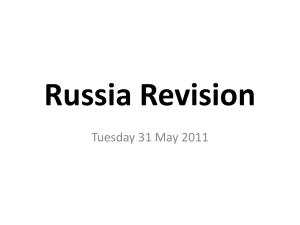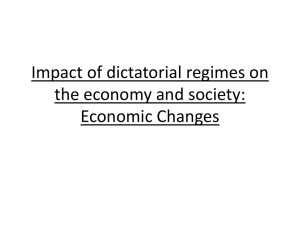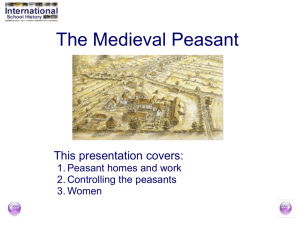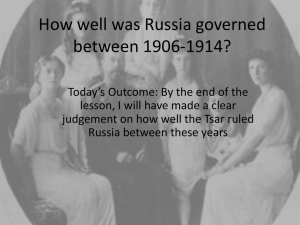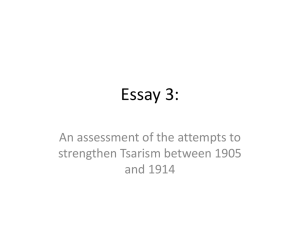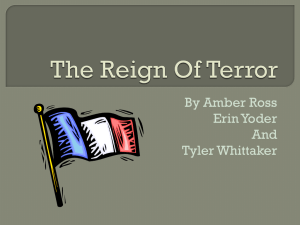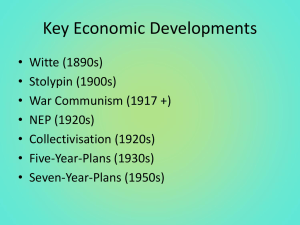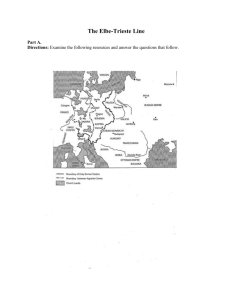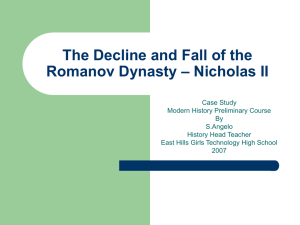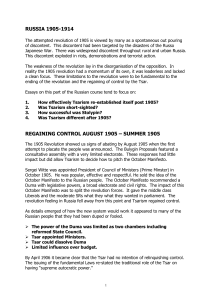Peter Stolypin Essay
advertisement
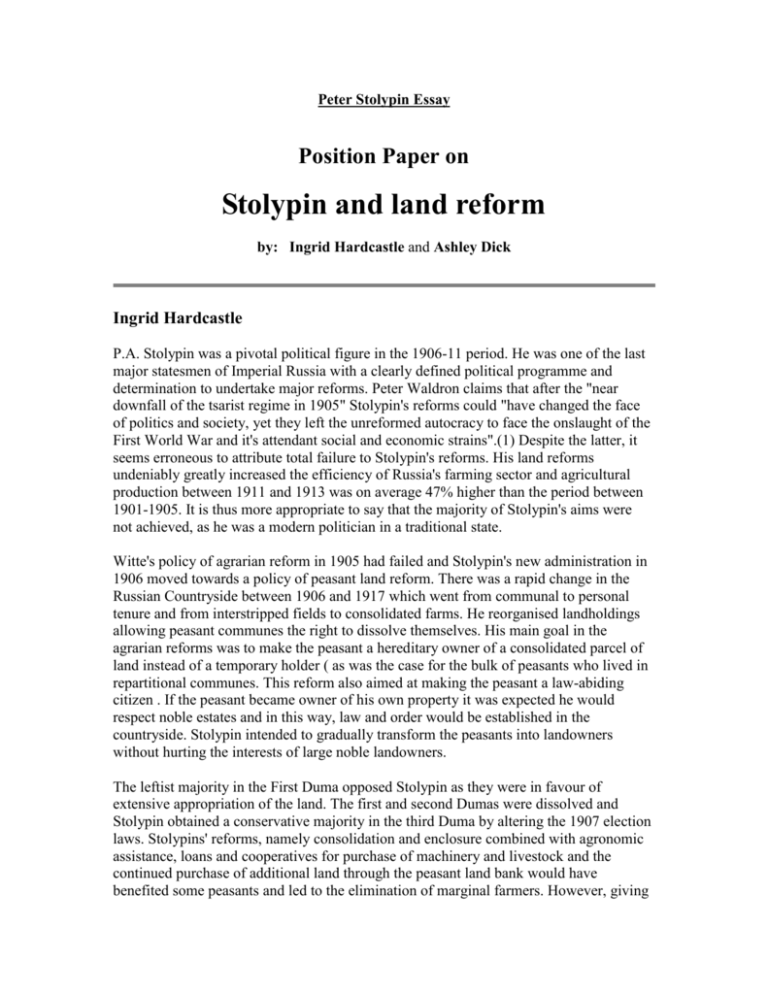
Peter Stolypin Essay Position Paper on Stolypin and land reform by: Ingrid Hardcastle and Ashley Dick Ingrid Hardcastle P.A. Stolypin was a pivotal political figure in the 1906-11 period. He was one of the last major statesmen of Imperial Russia with a clearly defined political programme and determination to undertake major reforms. Peter Waldron claims that after the "near downfall of the tsarist regime in 1905" Stolypin's reforms could "have changed the face of politics and society, yet they left the unreformed autocracy to face the onslaught of the First World War and it's attendant social and economic strains".(1) Despite the latter, it seems erroneous to attribute total failure to Stolypin's reforms. His land reforms undeniably greatly increased the efficiency of Russia's farming sector and agricultural production between 1911 and 1913 was on average 47% higher than the period between 1901-1905. It is thus more appropriate to say that the majority of Stolypin's aims were not achieved, as he was a modern politician in a traditional state. Witte's policy of agrarian reform in 1905 had failed and Stolypin's new administration in 1906 moved towards a policy of peasant land reform. There was a rapid change in the Russian Countryside between 1906 and 1917 which went from communal to personal tenure and from interstripped fields to consolidated farms. He reorganised landholdings allowing peasant communes the right to dissolve themselves. His main goal in the agrarian reforms was to make the peasant a hereditary owner of a consolidated parcel of land instead of a temporary holder ( as was the case for the bulk of peasants who lived in repartitional communes. This reform also aimed at making the peasant a law-abiding citizen . If the peasant became owner of his own property it was expected he would respect noble estates and in this way, law and order would be established in the countryside. Stolypin intended to gradually transform the peasants into landowners without hurting the interests of large noble landowners. The leftist majority in the First Duma opposed Stolypin as they were in favour of extensive appropriation of the land. The first and second Dumas were dissolved and Stolypin obtained a conservative majority in the third Duma by altering the 1907 election laws. Stolypins' reforms, namely consolidation and enclosure combined with agronomic assistance, loans and cooperatives for purchase of machinery and livestock and the continued purchase of additional land through the peasant land bank would have benefited some peasants and led to the elimination of marginal farmers. However, giving the peasants more land was not the answer to social unrest.The stolypin administration set up local resettlement boards with instructions to facilitate credit sales of gentry and state lands to peasants who were freed between 1906 and 1907 from redemption dues. However the land distribution to poor peasants through the land bank proved infeasible and many peasants decamped for Siberia. For the others the threat of establishing private property so upset patterns of land use that from 1907 onwards , whole villages began demanding land consolidation. Stolypin was the first Russian statesman who found the courage to defy tradition and allow the peasant commune to be broken up thus taking the risk of relying on the Kulak to meet the country's agricultural needs. He unlike others had attempted to treat the peasants as citizens on a footing of equality with the emperor's other subjects. His policy might have been successful as a social development and not just economic if the domestic conditions had been more stable. Note 1. P. Waldron, Between two revolutions: Stolypin and the politics of renewal in Russia (Northern Illinois Press, 1993) *** Ashley Dick Peter Stolypin became Minister of Internal Affairs in Russia from the spring of 1906. He combined this position with Russian Premier (Prime Minister) from 23rd July 1906 until his assassination in September 1911. Two perceptions of Stolypin have been developed. One view is that Stolypin exploited and misused his position of power merely to increase his status within the Russian government. This can be seen through his alteration of the Fundamental Laws and Article 87. Yet, perhaps Stolypin merely made slight alterations to these articles to ease the escalating revolutionary situation. It is clear his legislation did delay the downfall of the Tsarist state, and so perhaps these changes were a necessity for improvement of Russia's backward society. The first Duma was a failure. The demands made by Duma representatives would surely have led to the overthrow of the Tsar, thus Nicholas II ended it in July 1906. Following the collapse of the first Duma, Stolypin was appointed Prime Minister. He presented the second Duma with a series of reforms intended to remove major areas of social discontent. He was convinced that for the Tsar to respond negatively to the failure of the fist Duma, and to the terrorism which aggravated the empire would be fatal to the Tsar's power and may lead to him being overthrown. The peasant revolts of 1902 and risings of 1905 and 1906 showed where major areas of discontent lay. Thus, Stolypin planned to present reforms which would gain the support of the peasants who made up the majority of the Russian population. He hoped this would ensure the safety of the Tsar's rule. As well as reform of other areas of society, Stolypin placed focus on the agrarian problem. Stolypin brought about a series of reforms through the second and third Dumas that greatly improved the lives of the peasants. Peasants now had greater involvement in deciding upon their zemstvo representatives and had increased power in legal affairs. Despite the abolition of serfdom by the 1861 Emancipation Edict, serfs did not have real freedom. Instead of land being allocated to individual peasants, it was given to the peasant commune and thus the mir and peasant commune were retained despite serfs having supposed freedom. Behind these was the idea of shared communal land. Also, serfs were not yet officially free as they were still bound to the land until they had repaid redemption payments to their previous landlords which were to be paid over a 49 year period. Despite being a firm conservative, Stolypin recognised these restrictions upon the peasant class and their lack of individuality. He saw the peasant commune as ineffective and economically unproductive. Not surprisingly, this typically traditional Russian system was favoured by the Slavophiles and was clearly very different from the more advanced and modern Western Europe. Stolypin eased the situation with new legislation passed through the Dumas. In November 1905 redemption payments were abolished. With Stolypin's help this came into being from 1st January 1907. This enabled peasants to move around freely and so they now had the opportunity to seek work in the increasingly industrialising cities. A reduction of power was seen within the peasant commune and the mir. Peasants were now able to leave the communal system and become independent landholders. Peasants were given ownership of land if it had not been redistributed since 1882. This made many peasants private landowners and so was a success for Stolypin as he gained their favour through helping them to raise their status in society. Also, land could now be passed down from father to son. Stolypin also helped to create financial aid to peasants with the formation of the Peasant Land Bank, thus providing funds for peasants and their new land. It was Stolypin's aim to create a new type of peasant class. He did much to improve their situation and did contribute greatly to delaying the downfall of the Tsarist state. He did not solve problems but attempted to alleviate them. However, his land reforms were perhaps not enough to secure the continuation of Tsarist autocracy in Russia.

